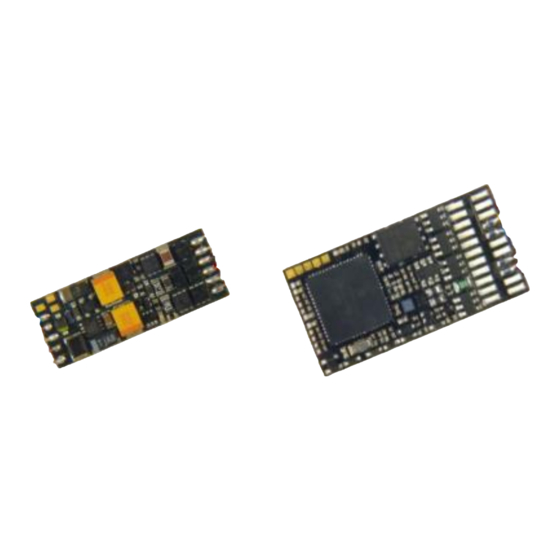
Table of Contents
Advertisement
Non-Sound Decoder MX600 - MX638 and Sound Decoder MX640 - MX659
INSTRUCTION MANUAL
THIN DECODER
MX600, MX600R, MX600P12
SUBMINIATURE - and MINIATURE DECODER
MX616, MX616N, MX616R
MX617, MX617N, MX617R, MX617F
MX621, MX621N, MX621R, MX621F
MX620, MX620N, MX620R, MX620F,
HO - and TT DECODER
MX623, MX623R, MX623F, MX623P12
MX630, MX630R, MX630F, MX630P16
HO, (O) - DECODER for MORE POWER or LOW VOLTAGE output or MORE FUNCTIONS
MX631, MX631R, MX631F, MX631D, MX631C
MX632, MX632R, MX632D, MX632C, MX632V, MX632W, MX632VD, MX632WD
MX633, MX633R, MX633F, MX633P22, MX637P22
MX634, MX634R, MX634F, MX634D, MX634C, MX638D, MX638C
MINIATURE - SOUND - DECODER
MX648, MX648R, MX648F, MX648P16
MX647, MX647N, MX647L, MX646, MX646R, MX646F, MX646N, MX646L
MX649, MX649R, MX649F, MX649N, MX649L
HO, (O) - SOUND - DECODER
MX640, MX640R, MX640F, MX640D, MX640C,
MX642, MX642R, MX642F, MX642D, MX642C, MX643P16, MX643P22,
MX645, MX645R, MX645F, MX645P16, MX645P22, MX644D, MX644C
ADAPLU (15, 50), ADAMTC/MKL (15, 50), ADAPUS (15, 50)
and: ADAPTER BOARDS
Decoder versions listed in gray are no longer in production
NEXT 18 - DECODER
MX622, MX622R, MX622F, MX622N
NEXT 18 - Sound - Decoder
MX658N18, MX659N18
First edition. SW version 25.0 for MX620, MX630, MX64D and MX640 - 2009 07 15
1
Overview .......................................................................................................................................... 2
2
Technical Information ...................................................................................................................... 5
3
Address and CV Programming ..................................................................................................... 13
Programming in "Service mode" (on programming track) ....................................................... 14
3.1
3.2
3.3
Decoder-ID, Load-Code, Decoder-Type and SW-Version ...................................................... 15
3.4
The vehicle address(es) in DCC mode ................................................................................... 15
3.5
Analog operation...................................................................................................................... 16
3.6
Motor Regulation ..................................................................................................................... 17
3.7
Acceleration and Deceleration: ............................................................................................... 20
3.8
The ZIMO "signal controlled speed influence" (HLU) .............................................................. 22
3.9
"Asymmetrical DCC-Signal" stops (Lenz ABC) ....................................................................... 23
3.10
3.11
3.12
3.13
Shunting, Half-Speed and MAN Functions: ............................................................................ 25
3.14
The NMRA-DCC function mapping ......................................................................................... 26
3.15
The extended ZIMO function mapping (not for MX621).......................................................... 26
"Unilateral Light Suppression" ................................................................................................. 27
3.16
3.17
3.18
3.19
Dimming, Low beam and Direction Bits .................................................................................. 30
3.20
Flasher Effect ........................................................................................................................... 32
MX618N18
3.21
F1-Pulse Chains (Only for old LGB products) ......................................................................... 32
3.22
Special Effects for Function Outputs ....................................................................................... 32
3.23
Configuration of Smoke Generators (for sound decoders) ..................................................... 33
3.24
Configuration of Electric Uncouplers ....................................................................................... 34
3.25
SUSI-Interface and Logic-Level Outputs (NOT for MX621) .................................................... 35
3.26
Servo Configuration (NOT for MX621) .................................................................................... 35
4
ZIMO SOUND - Selection and Programming............................................................................... 37
5
5.1
5.2
The test run for determining the motor's basic load ................................................................ 42
5.3
5.4
Basic settings independent of powertrain ............................................................................... 42
Steam engine Basic sound settings.................................................................................... 44
5.5
Steam engine Load and acceleration dependency ........................................................... 46
5.6
Diesel and Electric engines ................................................................................................. 48
5.7
5.8
Random and Switch Input sounds ........................................................................................... 52
6
Installation and Wiring ................................................................................................................... 52
7
ADAPTER boards, Energy storage ............................................................................................... 63
8
Predefined CV sets ....................................................................................................................... 67
9
ZIMO decoders and competitor systems ...................................................................................... 69
10
DC and AC Analog Operation ...................................................................................................... 70
CV - Summery List ....................................................................................................................... 71
11
12
Service Notes ................................................................................................................................ 78
13
INDEX ............................................................................................................................................ 79
ZIMO decoders contain an EPROM which stores software that determines its characteristics and functions. The software version can be read out form CV #7
and #65. The current version may not yet be capable of all the functions mentioned in this manual. As with other computer programs, it is also not possible for
the manufacturer to thoroughly test this software with all the numerous possible applications. Installing new software versions later can add new functions or cor-
rect recognized errors. SW updates can be done by the end user for all ZIMO decoders since production date October 2004, see chapter "Software Update"!
Software updates are available at no charge if performed by the end user (except for the purchase of a programming module); Updates and/or upgrades per-
formed by ZIMO are not considered a warranty repair and are at the expense of the customer. The warranty covers hardware damage exclusively, provided such
damage is not caused by the user or other equipment connected to the decoder. For update versions, see www.zimo.at.
Page 1
EDITION:
SW-Version 31 --- 2012 08 11
Loco boards chapter --- 2012 11 28
SW version 26.0 - 2009 09 26
New Family MX634 --- 2013 04 04
SW-Version 33.0 --- 2013 04 20
SW-Version 34.0 - 2014 01 01
SW version 27.0 - 2010 07 25
SW version 28.3 - 2010 10 15
MX649 added --- 2015 10 12
SW-Version 35.0 --- 2015 12 15
SW-Version 30.7 --- 2011 07 05
MX600 included --- 2016 02 02
Constant stopping distance ......... 24
2013 06 01
2014 10 12
2015 02 18
2015 07 14
2016 12 15
2018 04 13
Advertisement
Table of Contents
















Need help?
Do you have a question about the MX638 Series and is the answer not in the manual?
Questions and answers